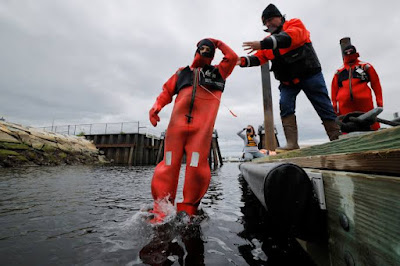- Some of America's most dangerous industries face cutbacks in worker safety training
- Fatal accident rate in fishing, logging and farming is seven times higher than U.S. overall
- Trump cuts to federal worker safety agency ripple through rural industries
By the time Robbie Roberge smelled smoke aboard his boat last August, it was already too late. The galley was in flames, fire racing up the walls of the Three Girls — a 70 Foot commercial fishing vessel named for his daughters. There was no stopping it. But Robbie knew what to do.
More than 100 miles off the coast, in the vast, unforgiving Atlantic, Robbie kept calm. He suited up his crew in survival gear, deployed a life raft, and made a mayday call that would save their lives. It was a textbook emergency response — and not by chance. Just three months earlier, he had taken part in a safety training course hosted by the Fishing Partnership Support Services (FPSS), a nonprofit that helps East Coast fishermen learn to survive the deadliest work conditions in America.
Robbie, a seasoned fisherman from South Portland, Maine, had spent decades at sea. But he admits: “I have years of experience, but not dealing with emergencies.” That training, he says, made all the difference. It’s why, on May 20 of this year, he cut a fishing trip short just to bring his six-man crew from another boat — the Maria JoAnn — to a new FPSS safety workshop in New bury Sport, Massachusetts.
But the kind of life-saving education that protected Robbie and his crew may soon be out of reach for thousands of fishermen like him.
The Quiet Dismantling of Safety Support
Behind the scenes, sweeping cuts to the federal government’s safety infrastructure have left the future of these programs uncertain. According to interviews with more than a dozen health and safety experts and organizations, the safety net for America’s most hazardous jobs — fishing, farming, and logging — is fraying fast.
At the center of the storm is the National Institute for Occupational Safety and Health (NIOSH). Once a robust agency under the Department of Health and Human Services, NIOSH has long provided crucial funding, research, and training support to the workers who risk their lives daily to feed and fuel the country.
But on April 1, the Trump administration slashed NIOSH’s workforce from around 1,000 to just over 100. About 875 employees were terminated — including nearly all staff who provided expertise and support to the agency’s network of safety centers nationwide.



